LOUDSPEAKERS 5.
HAND MADE USING NOS TANNOY DRIVERS.
In 2012, an old customer of mine in Melbourne wanted to create
another sound system with a pair of
bookshelf speakers and a low power 10W per channel integrated amp.
He searched all over the Internet for bookshelf speakers which
were tolerable, and affordable,or supplied
as a kit, and he found nothing he liked. The more he focused, the
more he expected and after many emails
with me he decided to have two pairs of speakers custom made.
I had too much work, and I was to retire in August 2012, so I
didn't offer to construct the speakers because
to build 4 speakers properly would have taken me several hundred
hours spread over months. He also
wanted the enclosures ( aka boxes ) made using bamboo plywood, a
difficult material to work. He also
wanted to use NOS Tannoy drivers, and because he was one of my
generation who was aware of the
"greatness of the past", there wasn't any way I could persuade the
man to accept a more modern three way
driver design which I insisted would give better micro dynamics in
music.
So I settled to design the enclosures to suit whatever Tannoy
drivers he could find. He would have to find a
woodwork craftsman to construct the boxes to my comply with my
design. He bought two pairs of Tannoy
drivers, 250mm dual concentric and 125mm dual concentric, both
pairs were probably made before 1975.
The supplier also sent crossover filter boards.
After receiving the 4 drivers and crossovers I tested all drivers
in temporary make shift boxes to establish
the ideal box volume and to make sure all drivers were not damaged
in any way. They all worked OK.
I drew graphs of their response using the supplied crossovers. All
4 drivers worked well enough to justify
proceeding further. I proceeded with formal box design.
My customer searched for a suitable craftsman. He found three,
with two located outside Australia.
After a number of emails he and I quickly realized Andrew Alston
in Australia was much better to deal with
than any of the others overseas. http://www.alstin.com.au/
Later in 2012, Andrew sent me the 4 boxes he'd made, and I
eventually found time to fit the Tannoy drivers.
Here are the design sheet details for the 2 pairs of speakers :-
Fig1. For 250mm or 10 inch drivers....
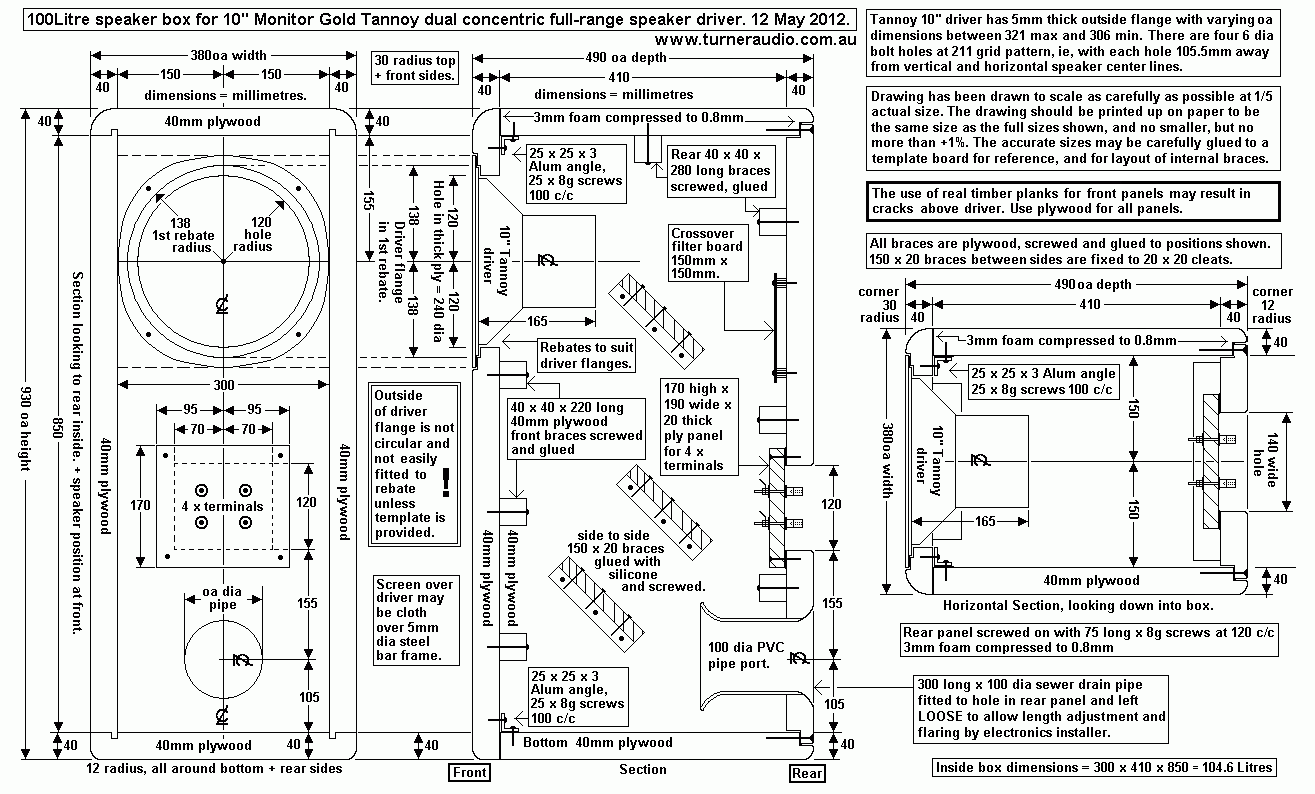
Fig 2. For 125mm or 5" drivers....

Wonderful woodwork arrived from Andrew Alstin,
Fig 3. Small and large boxes....
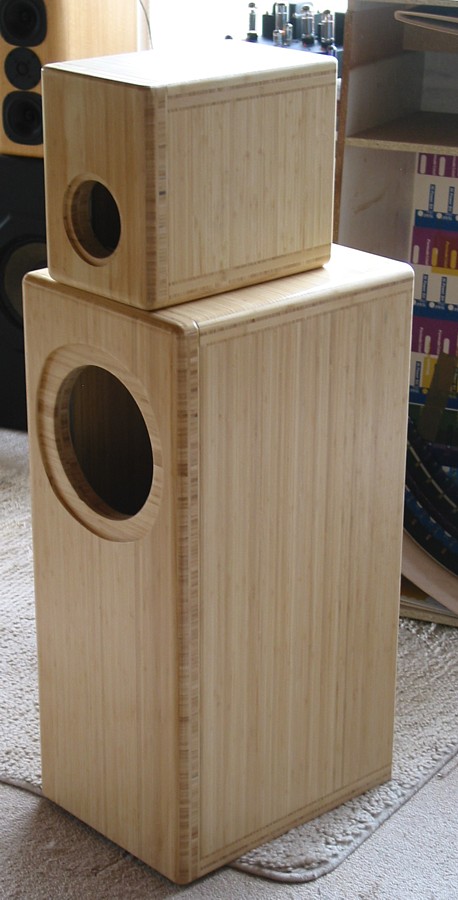
Fig 4. Small box inside view....
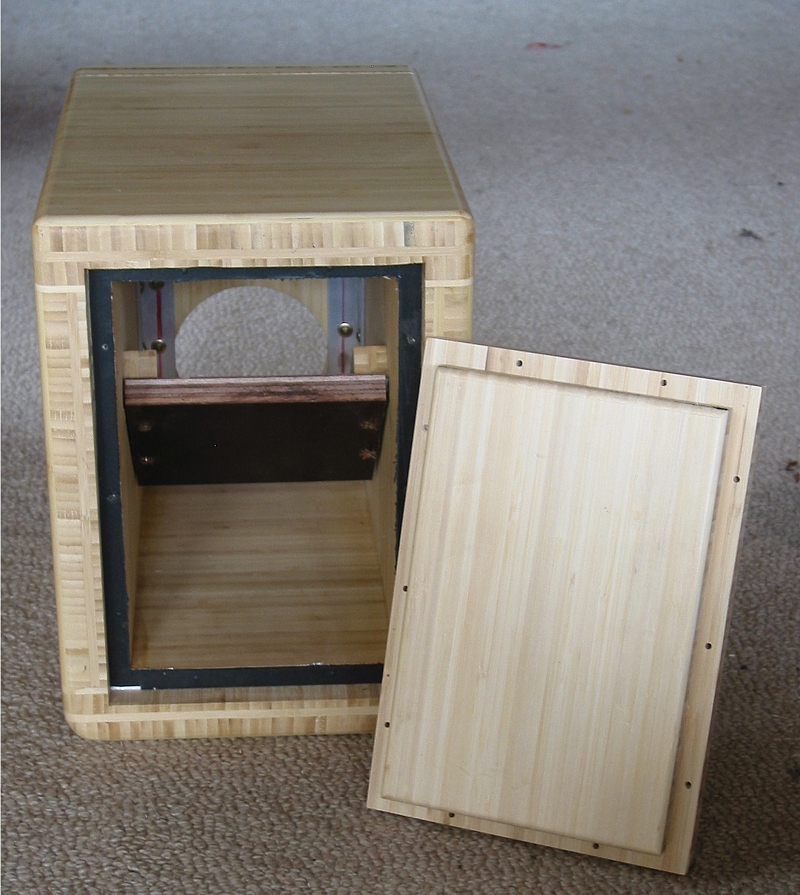
Fig 5. View of concealed internal fixing angles holding
front baffle to sides&top&bottom
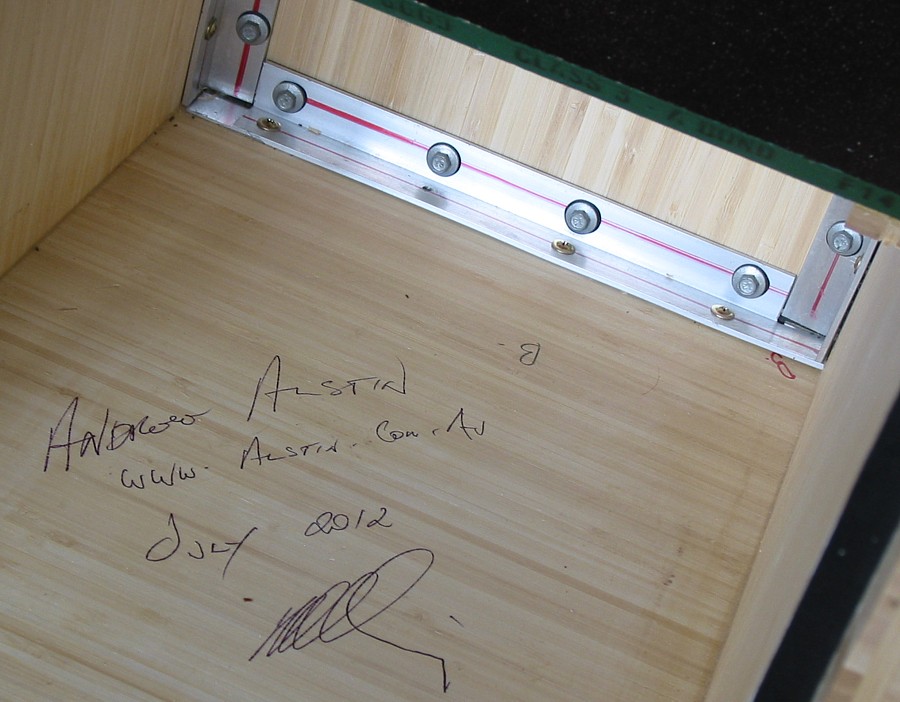
Fig 6. Internal view of large box with angles and braces.....

Fig 7. Completed large speaker, internal view.....
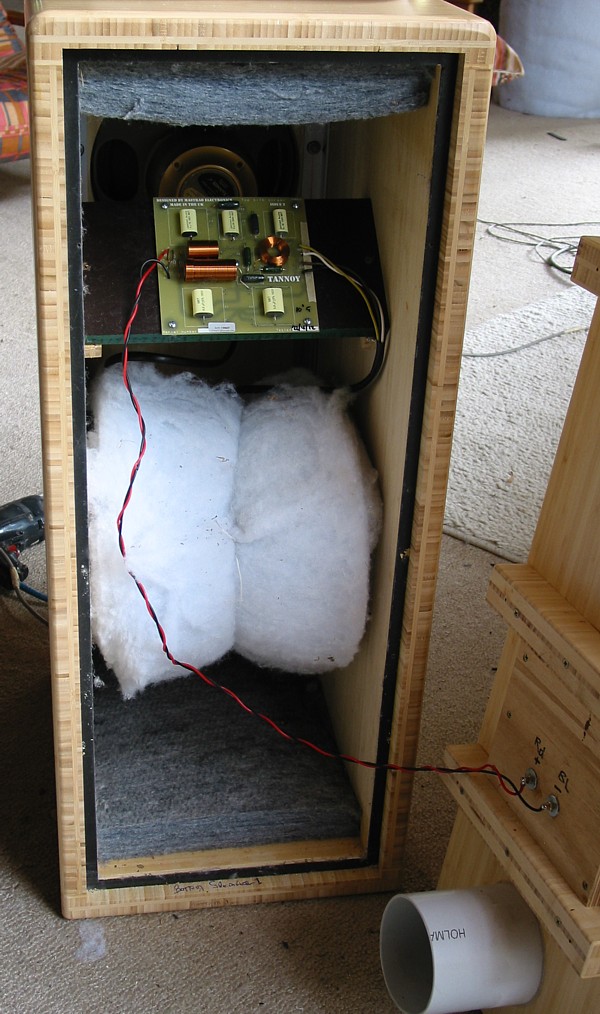
Note that the crossover boards for 250mm drivers were found give a
good flat response and there was
no need for any alteration. The board was fixed to a brace instead
of to rear panel. Flaring of the 150mm
long port was not required.
Before screwing the rear panel onto the box sides&top, the
crossover filter and brace had white polyester
wool wound around similarly to the two bottom braces. Grey high
density polyester wool is fitted to top
and bottom of box. The 40mm thick bamboo ply has enough mass and
inertia and bracing to prevent
it vibrating because of trapped sound from rear of cone.
Fig 8. Close up of crossover for 250mm Tannoy.
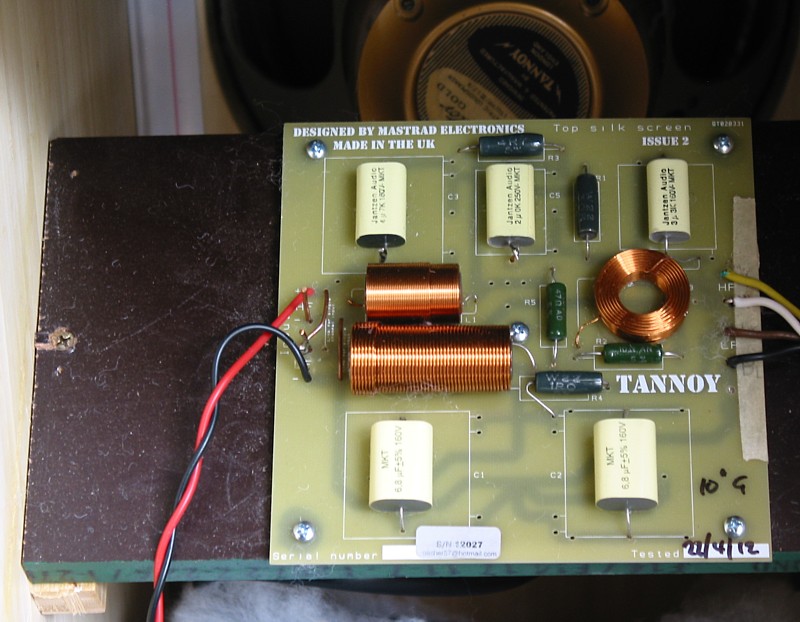
Fig 9. Inside view of small speaker....

Fig 10. Close up of crossover for small speaker....

Notice that the crossover has been hard wired onto the inside of
the rear panel of the speaker.
The crossover which was supplied gave very bad measurements and
very poor sound, and the
alterations needed made the supplied board redundant, although
some parts were re-used.
Following completion and adjustment and testing, parts were bedded
on silicone sealant and
couple of heavy coats of varnish were applied to anchor all parts
and prevent moisture ingress.
There is little one can do to raise the bass response of 125mm
dual concentric Tannoy.
But I have managed to improve it by using a network of 3r9 + 1.9mH
in series with the following
R, L and C parts.
There was no need to provide a port for the 125mm driver. It was
tried, but made only a tiny
difference which did not extend bass response lower.
Fig 11. Frequency Response.
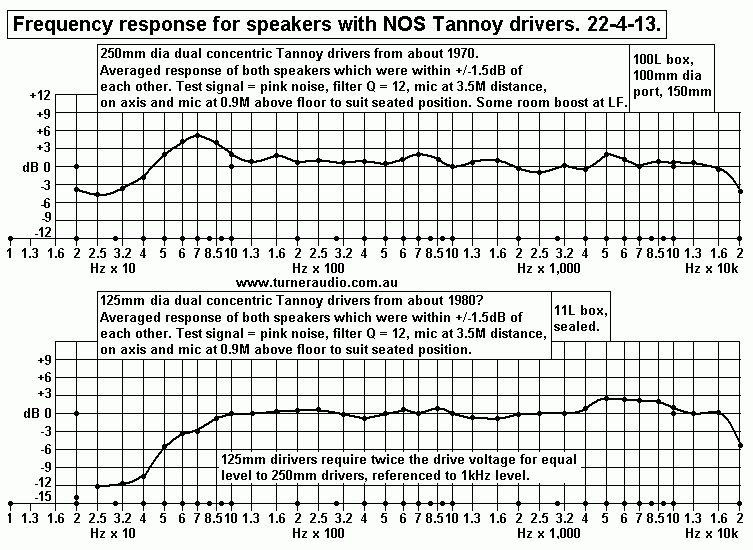
Both pairs of speakers were tested similarly. The small pair with
125mm drivers initially had very
poor bass content below about 130Hz, so a parallel L&R network
was placed in series and this
boosts bass to a minimum for acceptable music.
This meant the average response for 125mm drivers is -6dB below
average from 250mm drivers,
for the same voltage from an amp.
There is some heightened +2dB of treble between 4.5kHz and 9kHz,
but this may probably give
music more detail to be expected of such small speakers at low
levels. Some slight bass boost
may be applied by an amp to boost bass at low levels. High level
use of such small speakers
is not recommended.
Fig 12. 125mm crossover filter.....
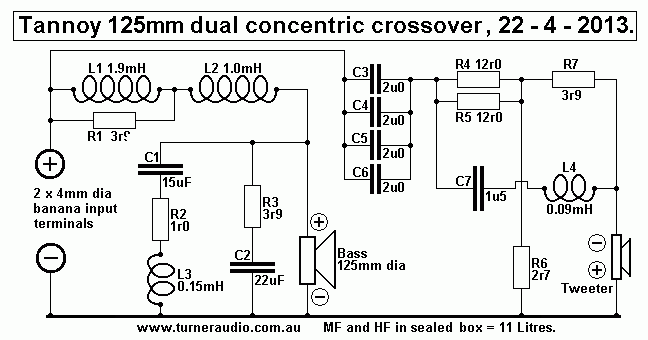
Fig 13. 250mm crossover filter....
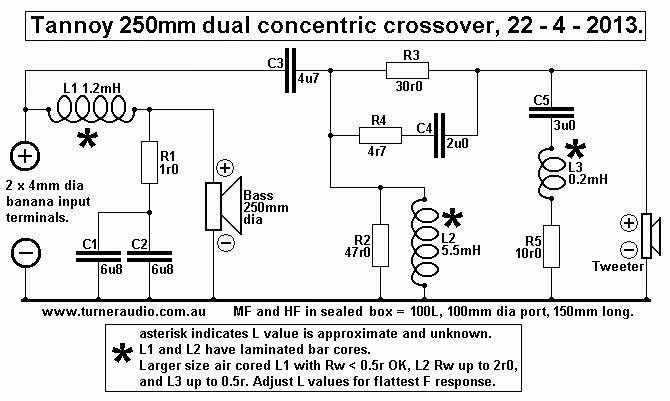
Fig 14. 125mmm impedance curve.....
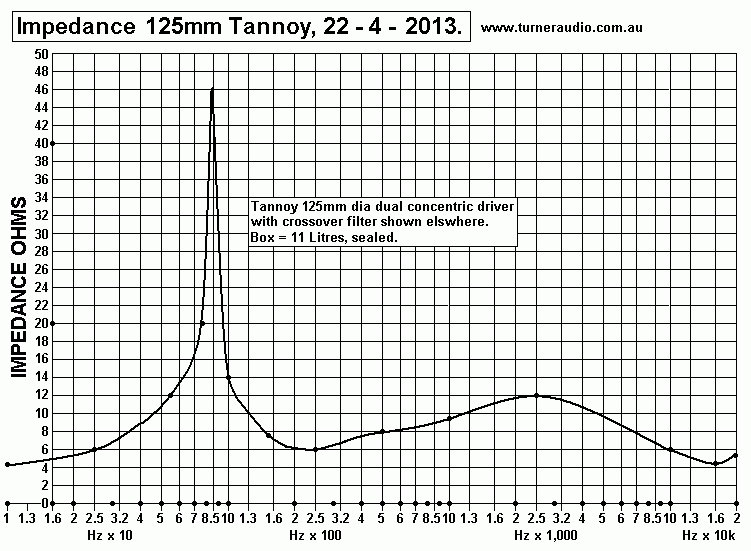
Fig 15. 250mm impedance curve.....
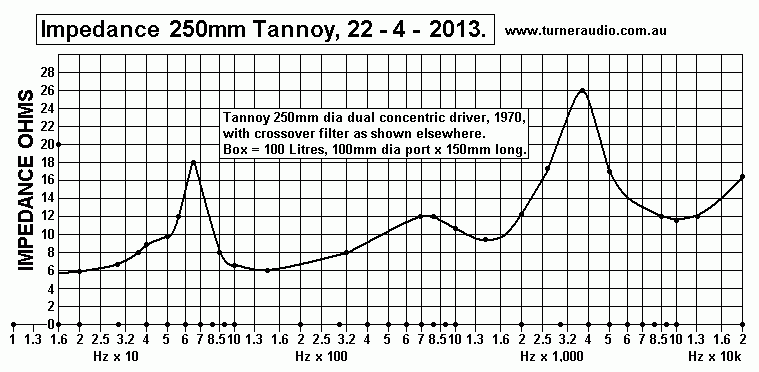
Fig 16. Completed 250mm speakers.
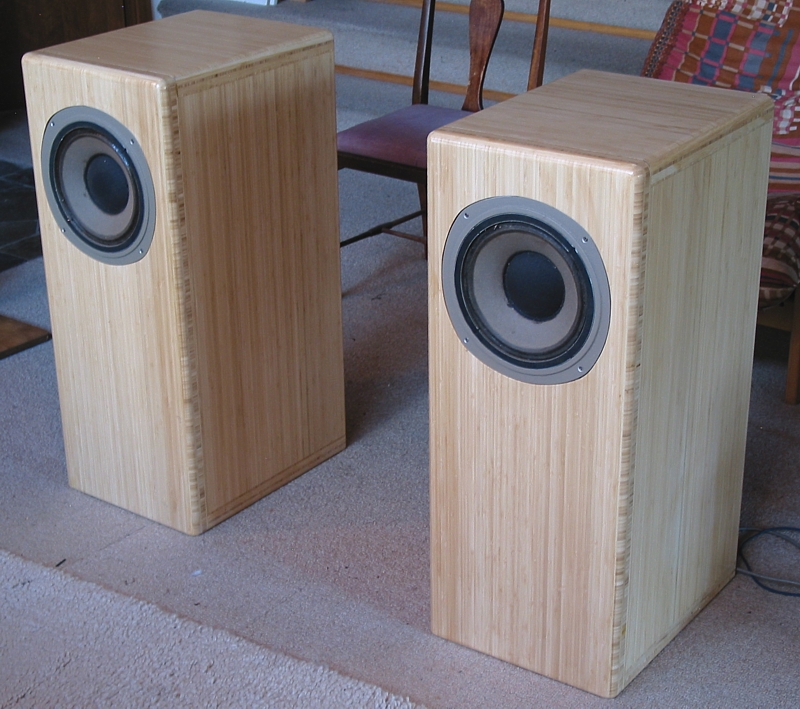
Fig 17. Completed 125mm speakers
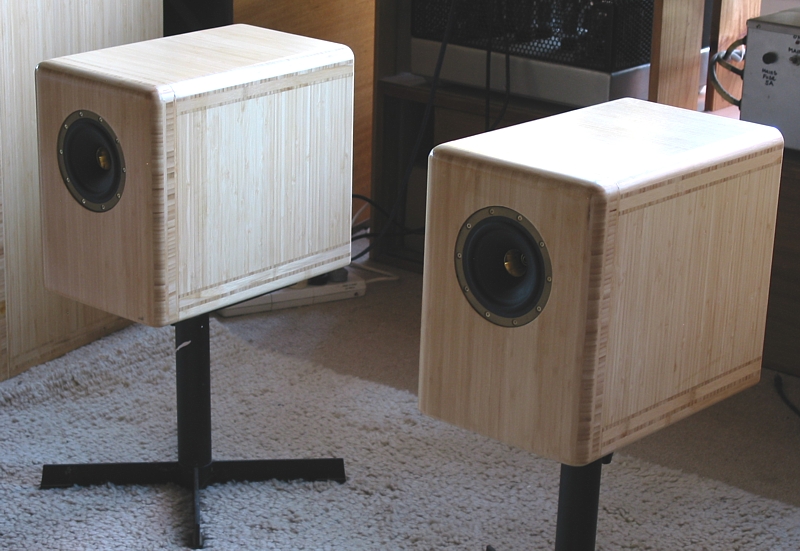
The finished speakers probably have far better box quality than
those made for the
equivalent range of Tannoy speakers made in the UK. The use of
40mm bamboo
ply which has density just above pine timber gives high weight and
a large amount of
inertia so that using floor spikes is not needed, IMHO.
I suspect the 4 drivers and crossovers cost about aud $700.00, and
4 bamboo boxes cost
about $5,000, and the cost for my design and time spent assembling
and testing was about
$2,200. Freight of boxes to me from joiner and then back to the
owner probably would be
$500. Total expense was $8,400. So cost of smaller 125mm pair
would be $2,800,
and cost of larger pair with 250mm drivers about $5,600.
One pair of 2013 model dual concentric 250mm Tannoy speakers
equivalent to what I have
produced would be the Tannoy Kensington. Details and prices were
found at
http://www.electronichouse.com/article/tannoy_kensington_se_review/audio
I quote the last part of the review.....
But is it accurate? Probably not. The Kensington SE might be
too much of a good thing.
It’s Technicolor rich, contrastier and flat out more
delicious sounding than any box or panel speaker
I’ve heard in ages. If I’ve made you curious, here’s my
advice: Listen to your favorite music first on
other speakers, and then audition the Kensington SE.
I’m betting you won’t want to go back.
PRICE :- Kensington SE: $13,120 per pair CONTACT :-
519.745.1158, tannoy.com
My conclusions,
Large units :- No obvious frequency deficiency, and well preserved
warmth in recordings. Great honesty
with bass, if not much was in the recording, you wondered where it
went, yet when bass-rich music was
played there was plenty, and plausible, with what you might hear
at a concert venue. Detail of massed brass,
violins and voices were as good as could be expected from a two
way speaker with crossover at 1kHz.
Overall, very listenable. Small units :- Slightly less bass,
unable to go to huge levels, but the intended use is for
close listening in a small room. Probably sound is more detailed
than larger speakers, and with surprising
level of bass, unusual for any speaker with one 125mm driver.
These are probably equal to the best of any other
brand of small coned bookshelf speakers.
The real value in the above design in in the boxes.
Small companies wanting to make speakers using the above design
would be able to used exactly
the same boxes with different drivers.
For example, 100L is a good size which would suit a pair of 200mm
bass drivers which often require 50L each.
The smaller 11L boxes will suit some other 125mm midrange driver
and there is room to install a high quality
dome tweeter. In 20 years time, when I am not here on Earth, and
replacement drivers are unobtainable,
perhaps some craftsman with excellent knowledge of speakers and
crossovers may be able to make
the change to an alternative set of drivers. Please do not order a
pair of handcrafted speakers from me now.
I have retired, and to make your own speakers as good as this
pair, you'd need to seek alternative man-power.
Back to Loudspeakers Directory
Back to Index 















